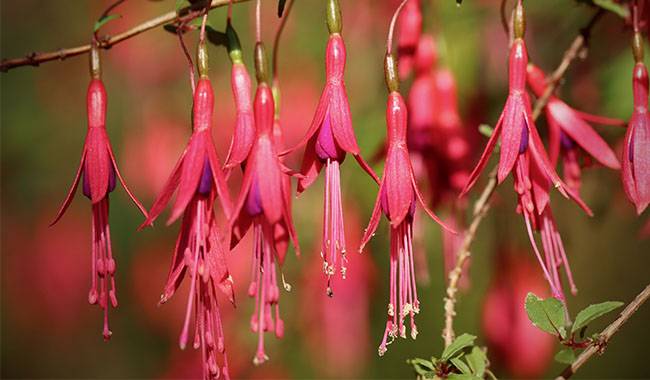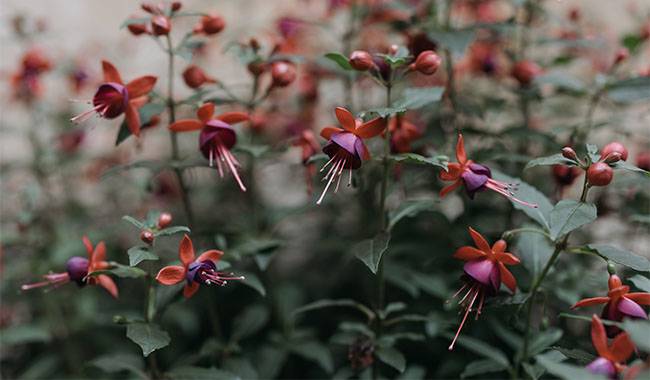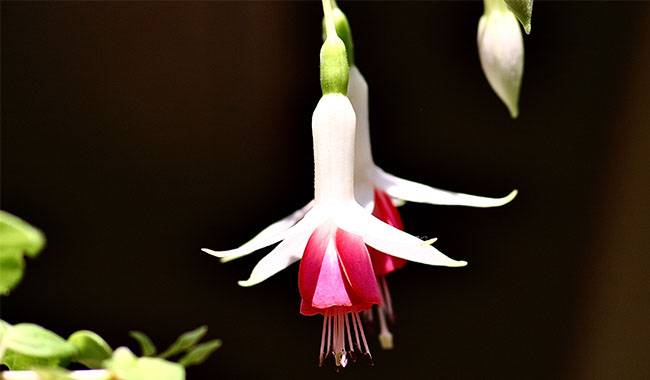
Fuchsia is known as the “ballerina” because of the unusual shape of this flower, which looks like the tiered skirt of a dancer. Many people appreciate it precisely for its pristine flowering period. I too succumbed to Fuchsia’s charms and bought a seedling, sacredly confident that soon my windowsill would be adorned with a cascade of delicate blooms. I was deeply disappointed when Fuchsia flowers did not bloom the year I bought them or the following season. But I still wait for it to bloom! I’ll share my experience growing Fuchsia flowers in this post. You will learn How to Grow Fuchsia in the ThumbGarden article.
FUCHSIA PLANT DESCRIPTION
Indoor Fuchsias (Fuchsia hybrids, Fuchsia x hybrida) are much more elegant than those that grow in the wild. In nature, they resemble small spreading trees or lush semi-shrubs studded with clusters of fragrant flowers. Fuchsia flowers were introduced to Europe in the 17th century by the explorer and botanist Leonard Fuchs. At first, it was considered a great curiosity and was planted in the winter gardens of the nobility.
Gradually, hybrids more adapted to northern latitudes were developed. This is how the bush type, the ampelopsis, and the semi-ampelopsis Fuchsia flowers developed. Today, Fuchsia varieties cultivated indoors are very rare; the vast majority of indoor Fuchsias are hybrids.
The flowers are available in swinging, semi-swinging, and regular types. The groups used for home flowering are different in the shade. White, purple, pink, beige, and violet are common. Usually, a combination of 2-3 shades can be seen in the structure of a flower bud.
GROWING CONDITIONS OF FUCHSIA

In trying to figure out why my Fuchsia was not flowering, I had to review and compare the care of each part of the plant with the benchmark. After talking to experienced florists, I learned that if a Fuchsia plant does not bloom.
- The optimal air temperature has been exceeded.
- the plant is affected by too much bright light exposure
- There is a lack of nutrients in the soil.
- Systematic irrigation errors are occurring.
- The plant is affected by a disease or pest.
After finding the root cause, I started to analyze the living conditions of my flowers.
Lighting
Fuchsia flowers grow well in diffused sunlight on the east and west windowsills. These beautiful plants grow well on northern windowsills even in semi-mountainous areas. fuchsia is absolutely forbidden to be in direct sunlight! They are so fragile that they immediately get sunburned.
I put it on a windowsill in the south. Although I put it in some shade on the big plant next door, it turned out to be very uncomfortable there. Since the east and west windowsills were already occupied and the north one was not, I put my beauty close to the south windowsill-about 60 inches (1.5 meters) on a sideboard.
Temperature
I think this was my main mistake, and the result was that Fuchsia’s flowers did not bloom. During its active growth phase, a temperature of 68-77 °F (20-25°C) is considered comfortable for it. And in summer, on my southern windowsill, it definitely exceeds 86 °F (30°C) In such conditions, Fuchsia’s leaves lose their elasticity and she doesn’t even think about flowering.
Dormant period
With proper care, Fuchsia flowers bloom from mid-May until November, after which they become exhausted and gradually go dormant. To help her, water gradually, stop fertilizing altogether and move the pot to a cooler place.
After the leaves fall off, cut the twigs back to 2/3 of their length and place the pot in a cooler place where the temperature does not exceed 50 °F (10 °C). Water very sparingly when the root ball has dried out to half its height. Starting in mid-March, the plants will be placed in a warmer corner and the sunlight hours will gradually increase to 8-9 hours.
If you leave Fuchsia in a warm apartment over the winter, it will weaken and may not bloom at all in the spring.
CARING FOR FUCHSIA FLOWERS INDOORS

Watering and air humidity
I have a clear watering schedule for different kinds of plants, among which I just include Fuchsia. fuchsias like a lot of watering. The benchmark is when the topsoil dries out. Sometimes I give the bush a bath and it is very receptive.
Tip: Remove excess water from the tray immediately to prevent root rot.
Fuchsia flowers are suitable for indoor Fuchsia flowers in medium humidity. This means they can use sprays in the summer.
Fertilization
Fuchsia is very sensitive to nutrient deficiencies. I fertilize weekly, but at half the rate specified in the instructions. I alternate between organic fertilizers and mineral composts for beautiful houseplants. fuchsia flowers require aggressive fertilization from spring to fall.
Similar to other plants sprinkle wood ash (1 teaspoon, no spoonful) on the soil surface every 14 days.
Diseases and pests
Fuchsia plants have been observed to be most frequently affected by gray rot. If you do not keep track of the amount of water applied or do not remove the water from the trays, it is enough to cause alarming spots and a gray coating on the lower leaves and stems.
To avoid trouble, I started using Gliocladin tablets (bisindole alkaloids). This product acts as a prophylactic and therapeutic agent, destroying the cells of disease-causing bacteria and fungi. It is both economical and safe for pets. According to the instructions, the tablets must be buried 2.3-2.7 inches (6-7 cm) into the soil when transplanting plants. When I saw the insidious blight, I simply stuck it in a pot, reduced watering, and sprayed the leaves with Epin. in my case, this complex measure worked and Fuchsia perked up considerably.
Spider mites, aphids, and whiteflies occasionally attack the flowers. To prevent them, I spray the leaves twice a season with carbon phosphorus. This is usually a mass treatment so that the pests do not migrate from one flower to another.
Propagation of Fuchsia
Fuchsia must be pruned occasionally in order to develop a neat appearance. I felt bad about throwing away the shoots, so I planted them under the jars. I had a lot of trouble with some disappearing, but two sprouted roots. Roots in water only appear in 14-21 days. To be sure new plants have rooted, you need 2-3 months when at least one new leaf appears.
Experienced growers use one leaf to propagate Fuchsia, separating it from the plant and placing it in the water. It takes 2-4 weeks for the first roots to appear, depending on the condition of the mother plant.
You can try to plant it immediately in a moist substrate, cover it with a cellophane bag or an overturned jar and monitor its condition by opening it daily for ventilation.
Rarely, Fuchsia is propagated at home from seeds. They are planted immediately in individual cups or boxes.
Dear readers! Fuchsia flowers are magical plants that can bloom and decorate any interior. If your Fuchsia does not bloom, do not despair! You can put your Fuchsia in your own room. If you change your conditions and adjust your plant care, you can enjoy a little “ballerina” bloom, as I did. Good luck!







